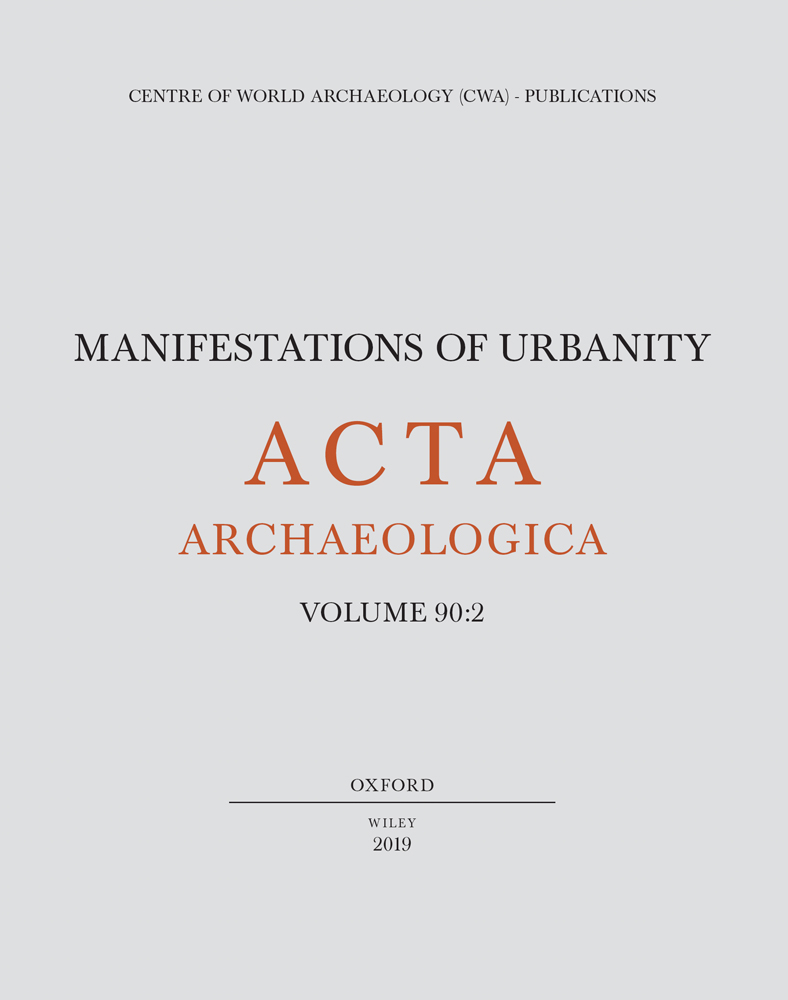THE STREETS AS A MEETING PLACE FOR DIFFERENT ACTORS AND AGENDAS: BUILDING AND USE OF OPEN SPACE IN 16TH-CENTURY NYA LÖDÖSE, SWEDEN
Mattias Öbrink
Statens historiska museer, Arkeologerna, Kvarnbygatan 12, SE-43134 Mölndal, Sweden
Search for more papers by this authorMattias Öbrink
Statens historiska museer, Arkeologerna, Kvarnbygatan 12, SE-43134 Mölndal, Sweden
Search for more papers by this authorABSTRACT
The town of Nya Lödöse, close to present-day Gothenburg, Sweden, existed from in 1473-1624. The material from the extensive archaeological excavations 2013–2017 presents the opportunity to study construction, use, and change of the streets. There seems to have been a clear hierarchy of streets, ranging from main streets to local streets and private alleys. This variety of streets covered different needs in the town's infrastructure. They were also the meeting point for different public and private actors with shifting objectives. Over time the authorities gained increased control over the streets, apparent in the material from the 1580s and onwards. This can be seen as a part of a Scandinavian trend linked to the emergence of the early modern state.
BIBLIOGRAPHY
- Ahlberg, N. 2005. Stadsgrundningar och planförändringar. Svensk stadsplanering 1521-1721. Acta Universitatis Agriculturae Sueciae, Agraria 94. Uppsala (Swedish University of Agricultural Sciences).
- H. Andersson, P. Carelli & L. Ersgård (eds.). 1997. Visions of the past: trends and traditions in Swedish medieval archaeology. Lund (Riksantikvarieämbetet).
- Andrén, A. 1985. Den urbana scenen. Städer och samhälle i det medeltida Danmark. Malmö (Liber).
- Andrén, A. 1998. Från antiken till antiken. Thorman & Hagdahl 1998. 142–184.
- M. Anglert & S. Larsson (eds.). 2017. Växjö, Kalmar och Smålands tidigaste urbanisering. Stockholm (Statens historiska museer).
- Anund, J. 2004. Interaction, Convention and Regulation. Infrastructures in Medieval Uppsala. Dunckel et al. 2004. 437–454.
- Balić, I., Brorsson, T. & M. Öbrink. 2015. Halmstad – från köpstad till fästningsstad. Öbrink 2015. 7–40.
- W. Börner, S. Uhlirz & L. Dollhofer (eds). 2012. Proceedings of the 16th International Conference on ‘Cultural Heritage and New Technologies’. Vienna, Austria 2011. Wien (Museen der Stadt Wien).
- Bengtsson Rylander, L. 2013. Rum för möten. Offentliga rum i tidigmoderna städer. Arkeologiska och historiska ingångar. Mastersarbete i arkeologi - MA Thesis in Archaeology. Institutionen för historiska studier. Göteborg (Göteborgs universitet).
- Bjuggner, L. 2000. Varuproduktion och hantverk i Halmstad från 1300-talet till 1600-talets första decennier. Urbaniseringsprocesser i Västsverige. En utvärdering av uppdragsarkeologins möjligheter att belysa historiska processer. GOTARC Serie C. Arkeologiska Skrifter No. 28. Institutionen för Arkeologi. Göteborg (Göteborgs universitet).
- R. Dunckel, M. Gläser, U. Oltmanns & J. Scheschkewitz (eds.). 2004. Lübecker Kolloquium zur Stadtarchäologie im Hanseraum 4. Die Infrastruktur. Lübeck (Schmidt-Römhild).
- Grauers, S. 1923. Nya Lödöse tänkeböcker (1586-1621). Skrifter utgivna till Göteborgs Stads trehundraårsjubileum genom Jubileumsutställningens Publikationskommitté VI. Göteborg (Elanders Boktryckeri).
- Hansen, G. 2005. Bergen c. 800-c. 1170. The Emergence of a Town. The Bryggen Papers 6. Bergen (Fagbokforlaget).
- Harlitz, E. 2010. Urbana system och riksbildning i Skandinavien. En studie av Lödöses uppgång och fall ca. 1050-1646. Institutionen för historiska studier. Göteborg (Göteborgs universitet).
- Holmbäck, Å. & E. Wessén. 1966. Magnus Erikssons stadslag. Vol. 7. Skrifter utgivna av Institutet för rättshistorisk forskning, grundat av Gustav och Carin Olin. Serien 1, Rättshistoriskt bibliotek. Stockholm (Nordiska Bokh. i distr.).
- Larsson, S. 2006. Gestaltningen av några skånska städer. Larsson 2006. 167–292.
- S. Larsson (ed.). 2006. Centraliteter. Människor, strategier och landskap. Stockholm (Riksantikvarieämbetets förlag).
- Larsson, S. 2017. Staden som idé. Anglert & Larsson 2017. 159–388.
- Nilsen, A. & G. Tagesson. 2018. Houses and Buildings – on Physical and Social Space in Early Modern Swedish Towns. Thomas & Campbell 2018. 39–50.
- Rosén, C. 1999. Föremål och social status i Halmstad ca 1550-1750. Urbaniseringsprocesser i Västsverige. En utvärdering av uppdragsarkeologins möjligheter att belysa historiska processer. GOTARC Serie C. Arkeologiska Skrifter No. 26. Institutionen för Arkeologi. Göteborg (Göteborgs universitet).
- Rosén, C. 2004. Stadsbor och bönder: materiell kultur och social status i Halland från medeltid till 1700-tal. Lund studies in medieval archaeology 35. Stockholm (Riksantikvarieämbetet).
- Seppänen, L. 2012. Lost but found underground. Construction, development and maintenance of medieval streets and squares of Turku (Finland). Börner et al. 2012. 476–492.
- Smith, M.L. 2008. Urban empty spaces. Contentious places for consensus-building. Archaeological Dialogues 15, 2. 216–231. https://doi.org/10.1017/S1380203808002687.
- Stibéus, M. 2014. Slaktarens kaj, apotekarens trädgård och fällberedarens gård: arkeologi på tre gårdar i 1600- och 1700-tal-ens Jönköping. Linköping (Riksantikvarieämbetet, Arkeologiska uppdragsverksamheten).
- Söderlund, K. 2004. Stockholm's infrastructure. Dunckel et al. 2004. 477–490.
- G. Tagesson & P. Carelli (eds.). 2016. Kalmar mellan dröm och verklighet. Konstruktionen av den tidigmoderna staden. Linköping (Statens historiska museer).
- L. Thomas & J. Campbell (eds.). 2018. Buildings in Society: International Studies in the Historic Era. Oxford (Archaeopress).
- Thomasson, J. 1997. Private Life Made Public, Aspects of the Emergence of Burghers in Medieval Denmark. Andersson et al. 1997. 697–728.
- Thomasson, J. 2004. A Feudal Way to Gentrify? The current understanding of gentrification and changes of social-topography in a medieval and early modern town. Current Swedish Archaeology 12. 187–210.
- S. Thorman & M. Hagdahl (eds.). 1998. Staden – himmel eller helvete. Tankar om människan i staden. Stockholm (Informationsförlaget).
- M. Öbrink (ed.). 2015. Vår by Broktorp. Halmstads äldsta historia. Hallands Länsmuseers Skriftserie No. 11. Halmstad (Stiftelsen Hallands länsmuseer).
- Öbrink, M. (ed.). 2016. Kulturella normer speglade av strukturer i en tidigmodern stad. META, historiskarkeologisk tidskrift. 111–126.
- M. Öbrink & C. Rosén (eds.). 2017. Undersökningar i Nya Lödöse. Stadsgård 1-4, gata A och B samt vretar. Arkeologiska undersökningar i Gamlestaden, Västergötland, Göteborgs stad och kommun, Göteborg 218. Nya Lödöse Rapport 2017:1. Göteborg (Statens historiska museer).
- Öbrink, M., G. Williams & A. Nilsen. 2018. Townscapes: Utopia and Practice in a Thematic Comparison of Nya Lödöse and Gothenburg. International Journal of Historical Archaeology 22, 2. 274–301.




